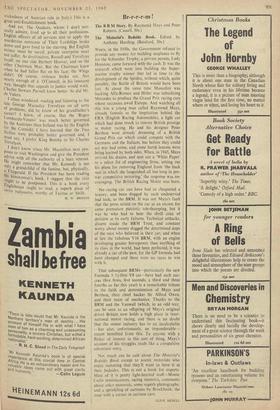Br-r-r-r-m !
The Motorist's Bedside Book. Edited by Anthony Harding. (Batsford, 30s.) WHEN, in the 1930s, the Government refused to provide any money for building seaplanes to fly for the Schneider Trophy, a private person, Lady Houston, came forward with the cash. It was the research which went into building the Super- marine trophy winner that led in time to the development of the Spitfire, without which, quite possibly, the Battle of Britain would have been lost. At about the same time Mussolini was backing Alfa-Romeo and Hitler was subsidising Mercedes to produce the Grand Prix racing cars whose successes awed Europe. And watching all this was a young man called Raymond Mays, already famods as the inspiration behind the ERA (English Racing Automobile), a light car which had done much to restore British prestige in motor racing. He and his designer Peter Berthon were already dreaming of a British Grand Prix car which could compete with the Germans and the Italians, but before they could act war had come, and some harsh lessons were being learned by both sides. When, in 1945, Mays revived his dream, and sent out a 'White Paper' to a select list of engineering firms, setting out his plans for removing England from 'the back seat in which she languished all too long in pre- war competitive motoring,' the response was en- couraging. The British Racing Motor was born.
No racing car can have had so chequered a history, and been dogged by such undeserved bad luck, as the BRM. It was not Mays's fault that the press seized on the car as an excuse for some premature patriotic tub-thumping, but it was he who had to bear the shrill cries of derision at its early failures. Technical setbacks, dissent inside the BRM Trust, and constant worry about money dogged the determined steps of the men who believed in their car; and when at last the fabulous V16 BRM, with an engine developing greater horsepower than anything of its class in the world, had been perfected, it was already a car of the past, for the GP formula had been changed and there were no races to win with it, That subsequent BRMs—particularly the new Formula 1 14--litre V8 car—have had such sue- cets (five firsts, five seconds, a third and three fourths so far this year) is a remarkable tribute to the faith and determination of Mays and Berthon, their chief backer Sir Alfred Owen, and their team of mechanics. Thanks to the BRM and the Vanwall (which, in an odd way, can be seen as an offspring of Mays's original drive) Britain now holds a high place in inter- national motor racing, and there is no doubt that the motor industry has to an incalculable —but also, unfortunately, an imponderable— extent benefited from this. To anyone with a flicker of interest in this sort of thing, Mays's account of his struggles reads like a compulsive adventure story.
Not much can be said about The Motorist's Bedside Book except to assure motorists who enjoy motoring that they'll want to have it at their bedsides. This is not a book for experts. Most of it is pretty light-hearted stuff—Monte Carlo reminiscences, racing memoirs, comments about other motorists, some superb photographs, and a sprinkling of cartoons by Brockbank, the man with a corner in cartoon cars.
CLIVE MEIKLE










































































 Previous page
Previous page